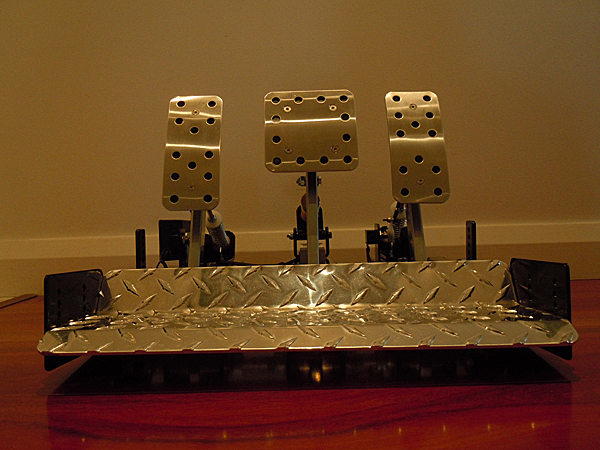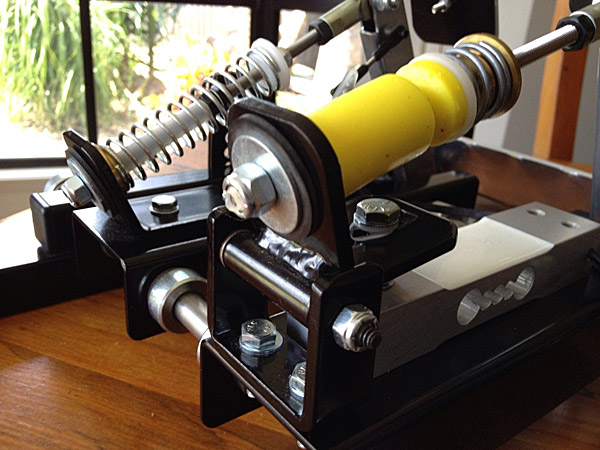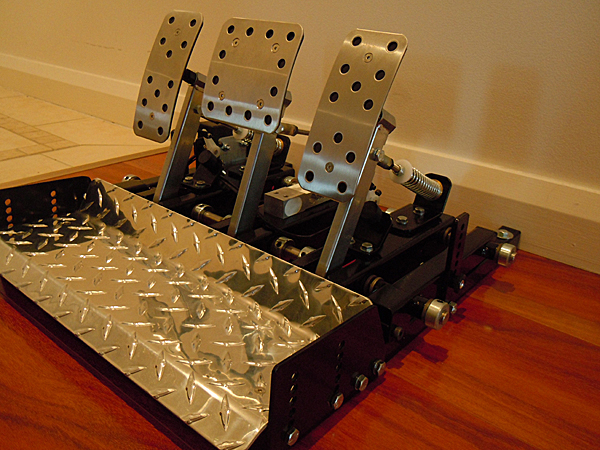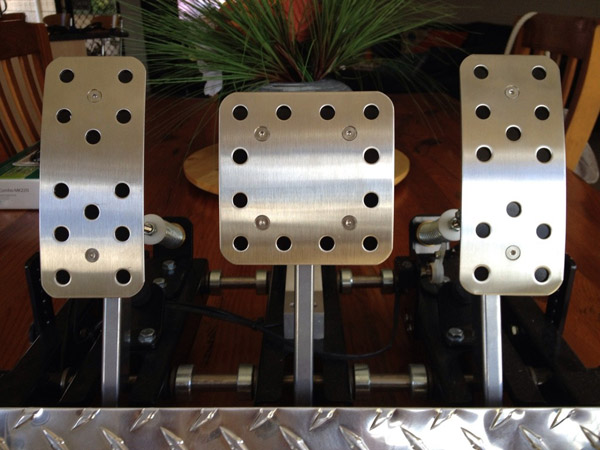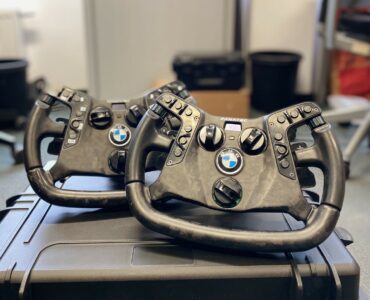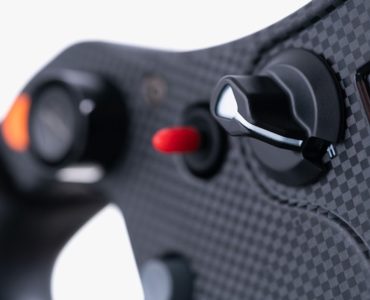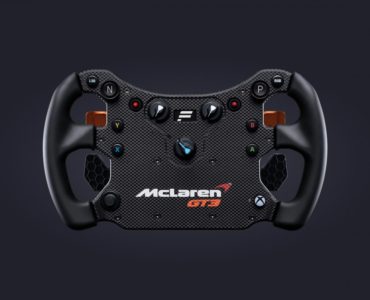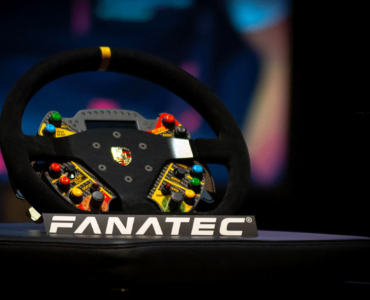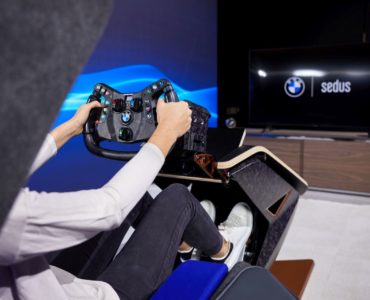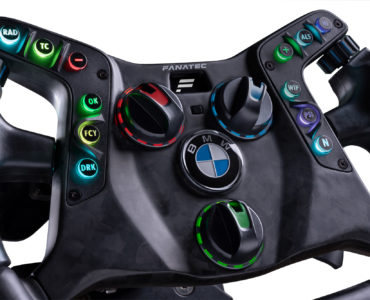Phill Routledge has written a very in-depth review of Cannon Simulation Technology’s F1 3B pedal set.
VirtualR is always happy to publish guest articles & reviews. Please visit the contact page to get in touch.
By: Phill Routledge
Today we take a detailed look at the simulation performance of Cannon Simulation Technology’s flagship “F1-3B” pedal set in titles such as rFactor, GTR Evolution and iRacing. Added to that is our comparison of the CST F1 – 3B pedals performance specs when compared to the Thrustmaster T500RS pedals, Fanatec Clubsport pedals, and the ever popular Logitech G25/G27 pedals.
We will review the CST F1–3B pedals based on differing categories as listed below.
Table of Contents
1. Meet the CST “F1–3B” pedal set.
2. Form Factor.
3. Build Quality / Feel.
4. Mounting / Adjust-ability.
5. Comfort of use.
6. Specifications and Calibrating.
7. Cost and Availability.
8. Conclusion
- Meet the CST ‘F1–3B’ pedal set.
From the second the parcel delivery man drops off your CST F13B pedals the very first thing that smacks you is the weight of the box your’e carrying very quickly to the closest bench / table to set it down safely.
Straight away from the onset you know you’re carrying a serious piece of enthusiast’s simulation kit. The second thing that strike’s you is the size of the box the unit comes in… Immediately you feel like you’ve received a little something that promises to be a bit special. The CST F1 3B pedals feature list is as follows:
[listfeature]- Pressure sensitive brake
- Analog clutch
- Steel construction
- Stainless steel pivots
- Self lubricating bushes
- Adjustable height
- Adjustable angle
- Adjustable pedal depth
- Adjustable pedal spacing
- Adjustable pedal travel
- Adjustable spring preload
- Powder coat finish
- 12 bit USB controller
- Option to add a button box
- Aluminum pedal faces
- Support XP, Vista and W7
- Form Factor.
The CST F1-3B pedals are not physically small. The 3 pedal kit as reviewed here will hold down firmly a considerable amount of cockpit real estate, spreading out to cover an area 475mm wide by 590mm deep. The layout itself is very reminiscent of what you would find in many real world circuit or rally style race cars, with the exception of course of the larger size footprint.
- Build Quality / Feel.
On build quality.
Basically, this is one area where the CST F1 pedals truly excel. A quick look all over the pedal kit reveals a build quality of a very high standard. To be honest, you could use these things in a real race car! They are just that solid and well made. Put short, they are not going to break anytime soon, and having said that, will last at least the longest time span of even the most committed sim racer’s career.
Add to that the always ready and friendly technical support of CST Australia’s sole distributor in Tony Pearce
(www.cst-australia.com) and you are well and truly covered now and well into the future.
On feel.
The pedals though basic and rugged by design are strikingly good at providing you with feedback. The throttle and clutch pedal’s rely solely on the compression force required to compress the spring, The springs CST have selected provide a good balance between the feeling of the resistance of compression, whilst still giving the racer the ability to easily modulate the travel position.
The brake pedal however is a completely different animal & it’s here the CST pedals come into their own.
Firstly so you the reader understands, I need to explain how it works. The brake pedal assembly uses a single point parallel beam type, aluminum load cell. These are more commonly used for price computing scales, bench scales, retail scales, counting scales and balances.
The CST F1’s load cell arrangement features a custom made “bell crank” type of arrangement that transfers the pedal force we apply into a lifting force directly onto the load cell. The resulting “stress” on the load cell alters the voltage output, and thus changes the data output to the PC via by the USB control box.
So, what does all this mean?
In short, the brake travel is a LOT more accurate than that as measured by potentiometers or pots as some people call them. So that describes how the brake pedal works in a simplified way, so now I can explain how the brake pedal feels..
First thing you notice is how hard the pedal is to push compared to the other two pedals on the unit or for that matter any other set you’ve ever used. On the set as delivered for this test, I could apply my whole body’s weight as hard as I could, pushing off of my race seat back onto the pedal. There was no movement in any direction other than as was intended. Now I weigh a good 100+ kg, (But don’t tell anyone!!) and what I can say is in all honesty, the pressure force I could apply on the pedal was so great that the only deflection I noticed was that of the back of my cockpits race seat wanting to flex away and retreat from the punishment.
I kid you not, the capability to apply that much force onto the pedal is well within it’s design parameters and in fact it’s a requirement when you are racing. It gives me an appreciation for the rig as I know from experience, real race car drivers do no less when braking, so it’s a welcome sight that a sim racing pedal expects you to do the same.
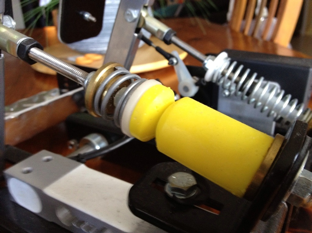
Brake pedal assembly with polyurethane bush and load cell underneath.
During use, the pedal initially starts out with an enticing feel, begging you to really lean into it. After you take up the initial spring load on the smaller/shorter brake spring you then begin to feel the crush effecting on the polyurethane bushing. So…, in effect it’s a two stage compression. Initially you have spring loading, followed by the much more firm crushing of the bushing.
What I found was after a small period of getting my head around this new requirement to deliver pedal force (getting the feeling for the pedals), I began after a few session’s to reduce my lap times. I found myself braking in a completely different way to how I do with my G27 set (unmodified). I found I could run deeper into the brake zone, and get onto the pedal with a huge amount of more aggression. I was really leaning on the brakes in a different way, and whilst doing it, not locking up the wheels. It’s this area where the lap time is found.
I honestly believe for me personally, the CST brake pedal was worth around a second a lap in a single hotlap format, over my usual G27 pedals. Understand everyone will be different, but none the less the difference was clearly measurable for me.
Now let’s reverse the scenario as I digress a little, Once I had to say goodbye to the CST F1’s I reinstalled my G27 set. Did I LOL the first time I pressed the brake pedal!! “OMG babe It’s a toy!” I yelled to my wife. The following night we ran a round of rFactor’s F1 2006 at Sepang with my sim racing league @ www.redlinesimracers.net plug intended.
Immediately my lap times in that particular mod, on that particular track were around 2.5 sec’s slower than the lap times from my previous night’s performance with the CST F1’s. I know for a fact around 1sec of that was all hardware, and the rest of that time loss was all… me…
So, what was going on here? The simple and true answer was that I had completely lost the feel for the car now I was back using the G27 pedals. In changing back, I was just not comfortable. Not at all.
Point of advice reader’s, that’s what change does to you. It has to be said that familiarity comes back to you again, it truly doe. It takes time to get that ‘feeling back’ and anyone upgrading up to CST pedals will be feeling the same ‘change symptoms’. It takes at least a couple of hours to transition and learn what makes the pedals tick, but once you start getting used to them, you won’t look back. This effect is known as “Muscle Memory” and you have to change the way you brake entirely to suit the load cell.
- Mounting / Adjustability.
Mounting made simple. That’s the best way to describe the way the CST F1 pedals can be mounted to your rig. A simple 6mm bolt with nyloc or similar coach screw or perhaps even a 12g timber screw (if into timber) will suffice. The pedal chassis has one 6mm hole on each exterior corner through the 25mm RHS frame. Fix them here and they will never move.
On adjustability, the pedals are surprisingly flexible. There has been considerable thought given to provide multiple directional axis of adjustment, enough to satisfy even the most particular racer. Adjustment includes pedal widths, pedal throw, heel plate height and distance relative to the pedal faces. This is just a few of the many options of adjustment made available.
- Comfort of use.
Once you get your head around the hardcore nature of these pedals they become very ‘normal’ in that this is what you expect a set of pedals in a real race car to feel like. Pedal throw, travel distance and resistive forces actually feel believable.
Over a prolonged usage period, say an endurance race of 50 or 60 laps, the pedals never gave me discomfort issues of any magnitude. Off course the key to any peripheral is taking the time to set them up correctly to ensure you have the optimal seating position relative to the pedals themselves. This is half the battle, and if done correctly will see you reap dividends in both driving comfort and your relative speed/consistency on race track.
To be honest, the only comfort gripe I could find, and this is very minor is that the included heel plate on my test unit was fabricated from chequer plate aluminum. My gripe with this was that, although it looked the bees knee’s for the most part, I personally race bare feet as I feel like I lose some feel of the car when driving with soles. In driving without footwear I found the patterns of the chequer plate quite sharp on my heels and after a time somewhat discomforting.
Now, to dispel any concern on this, know now you can order the same heel plate made with 3mm flat alloy that has no pattern embossed, removing the problem all together. Again it’s a personal taste thing, nothing more and can be corrected at time of order.
- Specifications and Calibration.
The CST F1 pedals run very high specifications of data resolution when compared to other of the shelf equipment such as Logitech’s G25/G27’s, Thrustmaster’s T500 RS and Fanatec’s ever popular Clubsport pedals.
Refer the table below for basic details outlining the differences between these 4 units in standard unmodified form.
|
|
Clutch Pedal |
Brake Pedal |
Accelerator Pedal |
|
Logitech G25/G27 |
(8 bit) 256 resolution steps |
(8 bit) 256 resolution steps |
(8 bit) 256 resolution steps |
|
Thrustmaster T500 RS |
(10 bit) 1024 resolution steps |
(10 bit) 1024 resolution steps |
(10 bit) 1024 resolution steps |
|
Fanatec Clubsport’s |
(10 bit) 1024 resolution steps |
(10 bit) 1024 resolution steps |
(10 bit) 1024 resolution steps |
|
CST F1 3B’s |
(12 bit) 4096 resolution steps |
(12 bit) 4096 resolution steps |
(12 bit) 4096 resolution steps |
So what we begin to see here is that the CST pedals provide approximately 4x more pedal position data output back to the sim over the T500 and Clubsport pedals. Even more incredibly, around 16x more pedal position data output than Logitech’s best offering.
This means effectively your control over the three pedals is massively amplified over the other offerings, giving you much better control over the car in the sim and put simply, it is this extra control that equates directly to lap time, and gives you that edge.
- Cost and Availability.
So far I have found it hard to find a flaw in the CST F1 3B pedal’s that mattered, however every rose has a thorn and in this case this rose has two thorns.
Cost.
The CST F1 3B pedals are not cheap by any stretch.
They are the flagship model pedal CST offer. I may add, a quick look at the CST US website strangely does not provide any information nor pricing on the CST F1 3B’s whatsoever? It’s almost as if they don’t exist in the US? or it’s possible perhaps the site was suffering a 404 linking error for quite some time or similar issue.
Happily however they can be found on the Australian distributor’s website with pricing clearly listed in AUD figures.
The unit as tested included;
- The base 3 pedal chassis,
- The optional wider brake pedal face plate,
- The optional adjustable floor bracket.
This assembly spec comes in at a hefty $1204 AUD price point.
Sadly, I believe this is more than the average sim racer can afford, however let’s not let this not detract, if you’re fortunate enough to be able to budget for these pedals, You get exactly what you pay for.
Availability.
Being completely honest, I have read and heard several comment’s on sim racing forums where people have made complaint on slow CST lead times on delivering product. I know not whether these maybe isolated issues, however the US site states a “typical” lead time of 6-8 weeks on delivery from placement of order, understand
however that this is a 100% handmade unit.
The best advice I can give you is to be sure you get a clear and concise answer in an email on the delivery window of the goods when you place your order with your local dealer.
- Conclusion.
In wrapping up this in-depth review of the CST F1 3B pedal set, I feel can safely say that at the time of testing and writing my review, that there is simply no better nor more accurate pedal set available to the sim racer today.
The CST F1 3B pedals are unashamedly hardcore by nature. They are targeted purely at the most avid, and most competitive of sim racer. The only chinks in its armor that I can find are;
1. It’s price tag and;
2. It’s delivery lead time.
But if you can afford the $1204 AUD asking price as tested and if you have the patience to wait that extra few weeks for delivery for a handmade, top shelf product than I can only highly recommend this pedal set.
I give the CST F1 3B’s a firm 9/10 stars.
We thank CST Australia for providing a loan set of the CST F1 3B pedals for this in-depth review;
The CST F1 3B pedals were reviewed intensively over an 8 week period by;
Phill Routledge | Admin and Founder www.redlinesimracers.net Australia’s premiere sim racing league.


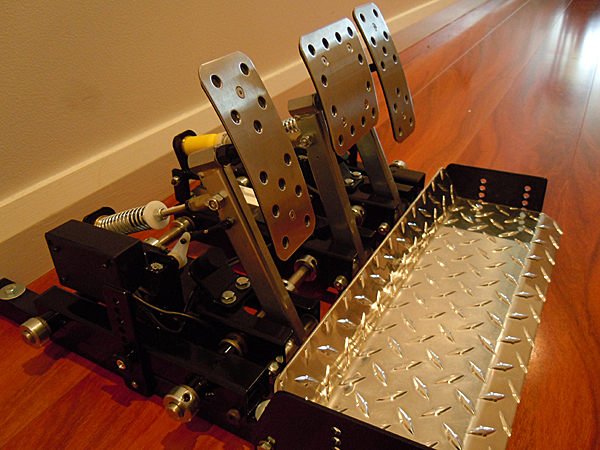
![1[2]](wp-content/uploads/2012/04/12.jpg)
